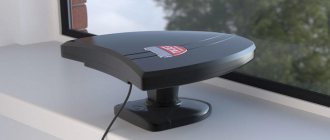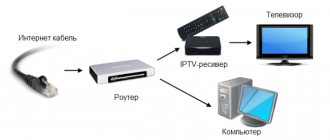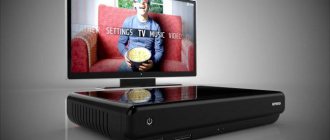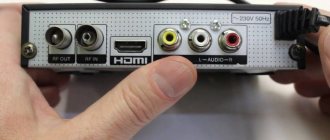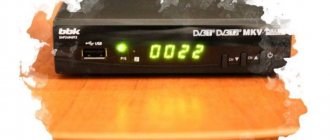In accordance with new legal regulations, Russian television channels must switch to digital television. Analog TV stopped broadcasting in October 2021, so the question now is how to switch to digital TV and watch TV with many channels again.
By the way, we recommend a useful article on our website about how the digital TV broadcasting standard differs from the analogue one.
If there are no problems with new TVs when switching from analogue to digital broadcasting (you can just plug the cable into the connector), then with old ones there are often difficulties. However, even on such TVs you can continue to watch channels, despite the fact that analogue broadcasting has stopped. In this article we will figure out how to set up an old TV and how to connect digital television.
Digital broadcasting allows you to increase the number of channels available for viewing even in remote regions of the country. The fact is that a channel broadcasting in analog format occupies an entire frequency. The same frequency can be filled with many channels at once, and the amount of interference that occurs will decrease. When broadcasting, viewers have more options - teletext, live voting, etc.
Digital broadcasting operates in MPEG4 and DVB-T2 format, so only new TVs will be able to receive such a signal without additional equipment. We recommend a useful article on how to find out if your TV supports digital. Regardless, there is a way to watch it on older TVs.
The disadvantage of broadcasting is that it requires new equipment. The state is prepared for this, but the population is not fully prepared. The cost of a new TV that could receive a digital signal starts from 5 thousand rubles. Naturally, not every person can afford such a purchase. Fortunately, there is a way out for such people - you can buy a tuner.
The main advantage of the tuner is that it already has channels with a tuned frequency (more than 20 pieces). You can watch them for free, with virtually no interference, and the image quality is high.
How to set up digital channels on an old TV
Digital TV is connected to an old TV using a set-top box (DVB-T2 tuner). The cost of such a device ranges from 600-1500 rubles. The tuner receives the signal and converts it into a supported format. It’s cheaper and easier to buy a set-top box than a new TV, but this also has its own nuances - you can’t always set up a digital set-top box.
Set-top box for watching digital TV
What TVs are digital set-top boxes suitable for?
Almost every modern TV is equipped with a connector for a special cable that transmits the signal. New TVs can receive and process it, as well as use additional functions of such broadcasting. Older models cannot do this, but if there is a tuner, then this task is assigned to it.
It is important to understand that by old we mean models that were released in the late 90s and early 2000s or later. These already have connectors that allow you to connect a tuner to them.
Older models, for example, Soviet tube models, are not suitable for receiving digital broadcasts, even if you use a tuner. Older models simply do not support connecting third-party devices.
If your TV has such connectors, you can easily connect a digital set-top box
If they are absent, you will not be able to watch TV. There are no additional adapters or connectors to which the tuner could be connected on very old (pre-90s) models.
Connecting a digital television set-top box on an old TV
To watch digital TV from an old TV, make sure you have the correct connectors. After this you need to buy a DVB-T2 set-top box. Any one will do for an old TV; they may differ in the number of channels. Before purchasing, you need to understand what connector you have. There are two types:
SCART connector . Looks like a plug. Combines audio, video and other connectors. In order to connect to it, you need to buy a special adapter (if the tuner is not already equipped with such a cable).
"Tulip". 3 connectors of different colors, mainly red, yellow and white (other variations may occur). Most tuners are equipped with just such an input.
So, you have decided which connector you have and whether you need additional adapters for connection. Now, let's find out how to connect a digital set-top box to an old TV.
Setting procedure
Turn on the TV to make sure it is working. We take our DVB-T2 tuner and connect an antenna to it. We have a special cable for this. To connect, screw the cord into the tuner, making sure the cable fits snugly into the input. Next, you can start connecting the tuner to the TV.
There are two options - Scart connector or “tulip”. If you have a “tulip”, then simply connect three wires to the TV, and then to the set-top box. It is important to do everything according to the colors, that is, white to white, yellow to yellow and red to red.
If you have a SCART connector, then you will need an adapter to connect “tulips” to it. On one side of the adapter there is a Scart connector, and on the other there are tulip inputs.
After connecting the tuner, check if it works. To do this, turn on the TV and tuner. The tuner comes with a separate remote control, so now you will have to constantly turn on the TV and the tuner separately. If you did everything correctly, then it should work, and you will be able to receive broadcasts and watch channels.
Tuning channels without an antenna
If you don't have a TV antenna in your home and don't want to buy such a device, you can still watch TV on your home screen. If the TV supports Smart TV, there is no need to worry at all. You can set up TV channels using an online cinema application or IPTV. We talked about how to do this earlier.
If the TV does not support Smart TV technology, you will have to contact your local television providers for help. In particular, Rostelecom has an Interactive TV service. It allows you to watch channels without using an antenna and a classic cable.
A potential client needs to visit the company’s office and conclude an agreement to connect Interactive TV. After this, the person will have a TV set-top box at his disposal, and all that remains is to follow a few simple steps:
- Connect the set-top box to a power source and the Internet using a Lan cable connecting the set-top box and the router.
- Connect the set-top box to the TV using an HDMI cable.
- Turn on the TV and switch to HDMI connection mode.
- Press the power button on the set-top box and wait for the updates to download.
This way, you won’t have to set up channels like you would on a TV. The set-top box automatically performs this operation, so that immediately after switching on, a person can watch all available TV channels.
What to do if the TV doesn't work
Sometimes it happens that the TV does not work despite the fact that a tuner is connected to it. The causes of problems vary; the most common ones are described below.
Antenna
One of the most common problems is an incorrectly installed antenna. Make sure the antenna receives the signal well. Ideally, it should be installed outdoors, but sometimes it works indoors. Try twisting it in different directions and see if the signal level changes depending on this.
Sometimes the TV does not work because the cable is damaged. Make sure it is not torn anywhere. See if it is screwed into the connector on the console well.
TV settings
Even old TVs had several operating modes - for receiving an analog signal, connecting to DVD, etc. It is possible that the set-top box is not working due to incorrect TV settings. Try switching different modes, your task is to find and select AV mode. It is designed to work with external devices, for example, tuners.
What to do if the TV shows a black and white image
It happens that when you connect a DVB-T2 digital set-top box, the picture becomes black and white and not color. The problem lies in SCART or “tulips”. Most likely, there was a partial wire break. Because of this, the TV shows the picture incorrectly.
How to set up cable TV
Cable TV is much easier to set up than satellite TV. After installing the cable, just open the TV menu and follow a few simple steps:
- Go to settings.
- Select cable as the antenna type.
- Select auto-tuning.
- Start the channel search process.
In just 10-15 minutes, the system will find all available channels and add them to the general list. After this, you do not need to change any settings. Just choose TV shows according to your taste.
Please note that menu item names may vary depending on the brand and model of your TV.
Tuner connections via VCR
For some reason, the TV may not accept the set-top box (the required input is missing or the equipment is not supported). There is a way to solve this problem - connect an old VCR, and to it, in turn, a tuner.
Tune your TV to the VCR channel and you'll be able to watch channels even if your old TV doesn't have an AV input.
Watching digital TV on a regular TV is quite possible, but to do this you need to connect and configure a digital set-top box. Tuners are cheaper than new TVs, but have similar functionality. Set-top boxes can work with TVs that have been produced since the mid-90s, but the main condition is the presence of a SCART connector or “tulips”.
Searching and tuning channels without a remote control
The TV is controlled using the remote control. But when such an important device is not at hand, you can still configure the channels. True, only if the TV is equipped with physical buttons:
- Turn on the TV.
- Press the Menu button.
- Using the channel switching buttons on the TV panel, find the “Channel Search” section.
- Confirm the operation by clicking the “OK” button.
- Start the process and wait for it to finish.
Not without difficulty, but you can still set up channels even without the remote control in your hands. In this case, the operation will take longer, but the result is guaranteed.
How to switch to digital television
In January of this year, digital television officially began operating throughout the country. Digital broadcasting is characterized by higher quality images and an uninterrupted signal.
What signal is your TV receiving now?
Turn on the TV and check if there is a letter “A” next to the Channel One logo. If this letter is not present, then you have a digital signal and you don’t need to do anything else. If this letter is there, then you have analog television and you need to take action.
How to switch to digital?
Almost all TVs released after 2012 support a digital signal - you just need to change the settings.
Owners of old TVs or users of an individual antenna will need a special set-top box.
Latest updates
My subscriptions:
© 1996-2019, Channel One. All rights reserved. Full or partial copying of materials is prohibited. When using site materials in an agreed manner, a link to the resource is required. Embed code for blogs and other resources posted on our website can be used without permission.
Online broadcasting of a broadcast stream on the Internet without approval is strictly prohibited. Broadcasting is possible only using the player and online broadcasting system of Channel One. Application for organizing a broadcast.
Information desk of Channel One tel.
In 2021, Russia made the transition of federal television from analogue to digital broadcasting. However, not everyone still knows what “digital” is, how it differs from analogue television broadcasting, and what equipment is needed for connection. We understand these and other issues that arise during the transition to digital TV.
Types of television signals
Today in Russia there are several types of television signals:
- digital;
- cable;
- satellite;
- Internet TV.
Digital TV
The most common type of television in our country is digital TV. It is also called etheric. To receive the signal, in this case, an antenna is used, which receives the image from the repeater. Digital television can guarantee the user 20 free TV channels and a whole host of paid TV programs. Their total number depends on the selected service provider.
Advantages and disadvantages
Low cost of services
Stable picture
Easy setup
Works in most Russian households
As a rule, HD versions of channels are not available from terrestrial TV operators
Since 2021, analogue TV has stopped working in Russia. It, like digital, provided signal reception using an antenna, but had a smaller selection of channels and relatively low image quality.
Cable TV
Cable TV is also very popular. It is distributed by special cable network operators. Unlike a regular “digital” image, the picture is not transmitted over the air (via an antenna), but through a cable that is directly connected to the TV without the use of third-party devices.
Advantages and disadvantages
Good signal quality
Large selection of channels
Easy setup
Large subscription fee on some tariffs
Satellite television
Satellite television was very popular in the early and mid-2000s, when there was no modern “digital” yet, and almost all people used analog TV. Satellite TV receives the signal using a special dish-shaped antenna. And the picture itself comes not from a repeater located nearby, but from a satellite flying somewhere in the sky.
Currently, people are abandoning satellite TV services. This is due to the high cost of equipment and a comparable set of channels in comparison with conventional “digital”. Nevertheless, the “satellite” helps out people living in rural areas where the classic digital signal does not reach.
Advantages and disadvantages
Uninterrupted high quality picture
Huge variety of channels
Available where other TV types are not available
Expensive equipment and expensive tariffs
Complex installation and configuration of equipment
Internet-T
Finally, Internet TV. This is the most modern type of television, the implementation of which, oddly enough, requires an Internet connection. And it doesn’t matter exactly how it will be configured. This could be Wi-Fi, wired or mobile network. The main thing is to ensure high data transfer speed.
Internet TV is implemented in several ways. The most common is the so-called interactive TV. It is a type of television when a special set-top box is connected to the TV, which works in conjunction with the Internet. Thus, the signal comes directly through the network.
You can also do without special attachments. Some TV models have applications that enable Internet TV. The user just needs to open a similar program, register and sign up for the type of subscription being made.
Advantages and disadvantages
Highest quality picture
Many channels
Large selection of viewing platforms
View control function
Easy setup
There are serious requirements for the TV, and if necessary, you need to buy an additional set-top box
You can watch Internet TV not only on a TV, but also on a smartphone, tablet, laptop and any other smart device with a screen.
Undoubtedly, the most advanced type of television signal is Internet TV. But such television is not yet very popular due to the poor technical equipment of Russian households. People are much more likely to connect to cable or digital TV.
Be that as it may, any person who wants to watch TV needs to consider in more detail each of the types presented in the material. In particular, you should understand how the settings are performed when choosing a particular type of TV. This is exactly what we propose to puzzle over.
Digital TV: what's new in it
Digital television is television in which video and sound are transmitted not simply using a modulated TV signal, but through a set of pulses containing encoded information.
Its basic differences from analog:
- High signal density. In the frequency range where one analogue TV channel is located, “digital” can transmit an entire multiplex - a set of several television channels (in Russia specifically, two federal multiplexes with 10 channels are transmitted for the most part, plus in some places it is possible to broadcast a third multiplex);
- Picture and sound quality. An analog signal is easily clogged with interference, but an encoded digital signal, even with fairly strong noise, can be restored without loss due to decoding algorithms.
- Easier to tolerate reinforcement. Where such attempts for an active analog antenna begin to cause distortion, the digital signal is received accurately. However, there is also a downside to quality: even a noisy analog signal still carries some information, while a digital signal is either received perfectly or is not displayed at all. Because of this, some parts of the data transmitted in packets may be completely lost. When a decoding program tries to restore information, the frame may freeze (in whole or in part), and sounds may be skipped.
Digital TV can be transmitted in the following ways:
- Cable broadcasting. This format is already familiar to many.
- Satellite broadcasting. It requires a parabolic dish and a decoder for a specific satellite broadcast system. Allows you to watch more digital channels, but also costs more.
- Internet broadcasting. Available for Smart TVs or when connecting an IPTV set-top box.
- On-air broadcasting. This will be discussed in this article. In 2019, a massive abandonment of support for analogue channels began. Now, instead of them, you can receive two on-air federal multiplexes, and in some regions (in Sevastopol, Crimea and in the reception area from the Ostankino TV tower in Moscow) a third one.
What to do if the TV is old
If the TV receiver was released too long ago and cannot be switched to digital reception, you can connect a DVB-T2 set-top box (also known as a receiver, decoder or tuner), which will convert the digital TV signal into video and audio signals available for viewing on the screen .
Important! If the TV is too old (for example, the Soviet “Horizon”), which does not have inputs such as SCART, RCA and others, you will have to buy a receiver with an RF modulator that converts the decrypted digital signal into several analogue ones.
Such receivers have an RF-OUT or ANT-OUT connector, to which you need to connect the TV via the antenna input and configure the reception of individual channels as if they were received from a regular antenna. Read more about connecting the set-top box to older CRT models.
What else do you need to connect?
Antenna
First of all, the TV signal must be received and for this you need an antenna. Here you need to remember that digital television broadcasts at ultra-high frequencies, so the antenna can be:
- decimeter (UHF);
- all-wave (UHF+MV).
UHF antennas for receiving digital TV are divided into the following types:
- Room. It is usually performed in the form of a small (15–20 cm in diameter) loop of wire rotating in a socket.
- Outdoor individual. This design is more serious. Usually it has the form of a rod with a set of resonator “horns” of gradually increasing length: from short at the end to long at the base. It can also be made in the form of a steel or copper plate with shaped slots (these are usually covered with a radio-transparent plastic cap to protect against damage), in the form of loop vibrators, etc.
- Collective. This is a complex design that requires precise configuration, installation, regular maintenance and power supply, but is capable of transmitting a signal to many subscribers using cables at once. It is usually used as part of the general equipment of an apartment building and the costs for its use are included in utility bills.
The choice of antenna depends on a number of factors:
- if we are talking about a city apartment or a dacha located near the repeater, you can use a regular room one;
- if the user is in the city, but the terrain or houses block the repeater tower from him, the connection should be made through a common antenna. This will ultimately cost less than installing an individual device of appropriate reception quality;
- in the private sector on the outskirts of cities or in rural areas, only individual antennas can be used.
Additionally, the following points must be taken into account:
- Distance to repeater. The radio wave, which is a television signal, weakens with distance. Therefore, the further you are from the TV tower, the more powerful the antenna is needed.
- Terrain. If there are obstacles in the form of hills and mountains between the TV tower and the antenna, they form a radio shadow that interferes with signal reception. Here you will have to either try to catch the reflected signal, or look for another repeater or another method of reception (cable or satellite dish).
- Building density. Capital structures made of brick and reinforced concrete are opaque to the TV signal. They will also create a radio shadow. This can only be avoided by moving the antenna to the side or up - to where the repeater will be in the zone of direct radio visibility.
- The height of the antenna placement. The earth is a sphere, and therefore the higher you rise, the larger the area will be visible. This rule also applies to the reception and transmission of UHF signals. Therefore, the antenna must be placed as high as possible.
The purpose of an amplifier is to strengthen a certain range of radio signals while filtering out airborne noise. This is necessary to ensure that the TV set or receiver receives the most powerful and high-quality signal.
Antenna cable
To connect a TV or set-top box with an antenna, you need to have a special cable with RF plugs. Room temperature superconductors have not yet been created, and even the best coaxial cables have a certain resistance. This causes attenuation to begin during signal transmission, and the longer the cable, the higher it is.
The exact cable parameters can be obtained from the manufacturer or an authorized seller. But in general, it is recommended to use the following brands of cables to connect the antenna, set-top box and TV:
100 m is the maximum length of the antenna cable at which the signal attenuates almost to zero. In practice, problems begin at a length of 20–30 m and above. If in doubt, it is better to consult with professionals.
Setting up digital channels
Searching for digital channels should also not cause difficulties for the user. It is carried out in exactly the same way as in the case of cable TV, with only one exception. Where the type of signal reception is indicated in the TV menu, you need to select the antenna or the “Terrestrial TV” value. Next, we simply start searching for channels and wait for the final results.
Depending on the number of available channels, the search will take 5-20 minutes. In addition, before performing the operation, it may be necessary to install additional equipment, which includes an antenna. Apartment buildings have a common antenna, so you just need to connect the cable to the TV and start tuning the channels. But in the private sector you will need your own antenna. It can be purchased at most electronics stores.
Installation and connection procedure
Determining the required antenna type
First of all, you need to establish the conditions of admission. The most convenient way to do this is using the CETV online map. There you need to set your location and the service will show the distance to the nearest TV tower.
You need to focus on the following:
- distance from 0 to 15 km – an indoor antenna is sufficient;
- 15–30 km – external individual or collective is needed;
- 30 km or more - you need an individual, precisely targeted one;
- 50 or more – a highly targeted personal one with an amplifier is required;
- more than 50 – reception is possible, but it is better to think about buying an antenna and a satellite TV receiver or connecting to cable TV.
Installing the antenna
If a collective one is used, then the wizards have already installed it correctly. Therefore, we will talk about indoor and outdoor individual ones.
The installation diagram is simple, you need to follow the following rules:
- The higher the better. Even the room one needs to be raised to the ceiling. It is better to place an individual one on a very high mast.
- The antenna must be clearly oriented towards the repeater. The exact bearing can be found on the CETV map.
Connecting the equipment
- The antenna is connected to the TV. The RF-IN connector is used.
- If the TV cannot receive “digital” (you can check this here), then first the antenna is connected to the tuner (receiver), and only then via RCA, SCART, HDMI or another available connector to the TV. We recommend that you follow the detailed instructions for connecting a digital set-top box.
- If a separate amplifier is used, it is connected to the antenna.
Setting up channels
- Using the remote control or service buttons, switch the TV to the “Menu” mode, and then to the “Settings” position.
- Go to "TV", "Reception" or similar.
- Select the "automatic" search mode, and then the signal source (antenna, DTV or similar).
- Start auto search. The exact parameters depend on the specific device interface.
- In order for the channels to be saved in memory, you need to press the “OK” button each time, otherwise after turning off the TV you will have to retune everything again.
That's all! All you have to do is sit back on the couch and enjoy your new digital TV.
Frequently asked questions about switching to digital
How much does digital terrestrial TV cost?
By law in Russia, reception of a basic set of federal multiplexes is free. Therefore, 20 channels throughout Russia can always be received without a subscription fee.
How many digital channels can you catch?
The situation is similar in Crimea and Sevastopol: a third multiplex of local channels also broadcasts there, although there are fewer of them than in Moscow (8 versus 10).
The government plans to launch broadcasting of the third multiplex throughout the Russian Federation. However, for economic reasons, this goal is not included in the program for mass transition to digital broadcasting in 2021. The timing of the commissioning of the third multiplex at the federal level has not been determined even approximately.
Will analogue channels be picked up now?
The program for the transition to digital broadcasting means that there will be a refusal to broadcast federal channels in the form of an analog signal. However, the legislation does not prohibit local television companies from going on air.
Is it possible to connect several TVs?
Several television receivers can be connected to one antenna. For personal antennas, this rule also applies, and users who want to have separate TVs in the living room, bedroom and kitchen can simultaneously watch different programs on them. However, it must be borne in mind that sometimes they will require separate receivers.
Do I need to connect digital if I have cable or satellite?
If you are already a subscriber of a satellite or cable operator, then you don’t have to worry about the end of analogue broadcasting in Russia: all 20 channels of federal multiplexes are definitely there. Moreover, the providers' packages also include regional channels that continue to broadcast in an analog signal.
Is it possible to get a digital set-top box for free?
Set-top boxes are usually sold in consumer electronics stores. However, there are categories of citizens who can receive it for free. These include:
If you don’t have an antenna, but want to watch digital TV, you can do the following:
- Connect cable TV. Yes, it's paid, but there are a lot of channels and no problems with interference.
- Use IPTV. This is interactive television, which is connected by the Internet provider using the subscriber’s IP address. Today this service is available in all regions of Russia. If the apartment is already connected to the Internet, you don’t need an antenna - just set up a Wi-Fi router or a direct LAN connection.
- Build a homemade receiver. If the repeater is in direct line of sight and within a radius of 15 km from the house, it is enough to make an antenna from a coaxial cable, soldering one end to the core and the other to the braid. If you want to do something of better quality, you can, based on the transmission parameters, calculate the dimensions of a double rhombus, the dimensions of a loop resonator or a log periodic antenna in an online calculator, and then assemble it from materials that are sold in any hardware or radio store. Read more about homemade DVB-T2 antennas.
Setting up channels on Smart TV
Smart TV technology turns an ordinary TV into a truly smart device. The TV receiver is acquiring new functions, including the ability to watch TV shows via the Internet.
At the same time, on a TV that supports Smart TV, you can watch channels in exactly the same way as on a regular device. For example, using satellite, digital or cable TV. As practice shows, the vast majority of owners of TVs with Smart TVs choose one of the previously discussed methods. And they use the benefits of Smart TV to watch videos on YouTube and movies in online cinemas.
However, there are those who abandon classic television completely. A fairly large group of people watches not only films and short videos via the Internet, but also familiar TV channels.
To watch TV via the Internet, you need to download a special application on your TV. It can be any client of an online cinema with a set of TV channels. For example, MEGOGO. The program of the same name is available on almost all TVs with Smart TV, so the user can only open the application store and download MEGOGO.
Next, you need to launch the program and create an account if you have not used any account before. After this, the owner of a TV with the Smart TV function must sign up for one of the types of subscriptions in the corresponding section of the menu. Each subscription has a specific type of channel, so it is recommended to base it on your own preferences.
On MEGOGO you can watch 20 federal channels absolutely free without a subscription.
Now that the application is configured and the subscription is completed, you can safely watch TV channels via the Internet on your Smart TV. The program also allows you to use the rewind and delayed viewing function if the client has such a need.
MEGOGO is an absolutely legal, but at the same time paid method of watching TV on Smart TV. As an alternative, it's worth checking out IPTV. Unlike official online cinemas, this method is not entirely legal.
IPTV on Smart TV works using a special application. For example, SS IPTV. In the program menu, a person needs to insert a link to a playlist with channels, after which a detailed TV program will open with the ability to select a specific channel. Typically, watching TV via IPTV is free, which is why copyright holders often block broadcasts.

